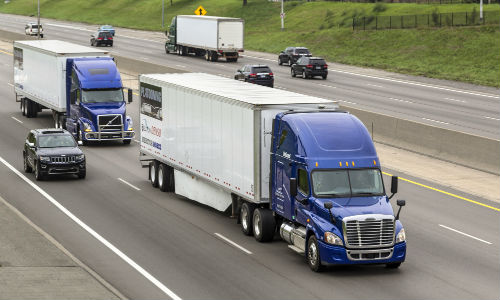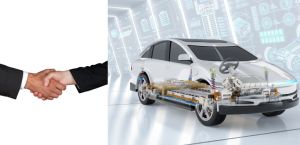By Jeff Sanford
Toronto, Ontario — December 11, 2016 — The biggest news in the autonomous vehicle (AV) space this week comes from Michigan, where the government has created what might be the most AV-friendly regulations to date. We also look into Peloton’s system for platooning transport trucks, why Silicon Valley ran into trouble in the real world and much, much more!
– Fortune reports that Michigan Gov. Rick Snyder has signed a package of “automaker-backed bills” last Friday that aim to clear the way for self-driving cars to operate on public roads and re-establish the state “as the epicenter of automotive innovation …”
The bill will see Michigan leapfrog past California in terms of the loosest regulations to test self-driving cars. The new laws, “… allow testing of vehicles without steering wheels, pedals, or needed human control.” As it is California requires that fully autonomous driverless cars have a steering wheel or a brake pedal. Michigan’s new laws also allow automakers and tech companies to run autonomous taxi services and permits test parades of self-driving tractor-trailers as long as humans are in each truck.
One bill also establishes, “… the Michigan Council on Future Mobility, an arm of the Michigan Department of Transportation that will recommend policies to set industry standards. The council will regulate connected vehicle networks and how traffic data, such as vehicle crashes, will be collected and shared.”
– Peloton is a company working on a “two-truck system” that provides a wireless communications link between heavy trucks, enabling pairs of trucks to coordinate their speeds and maintain a safe, aerodynamic following distance.
The system “intelligently orders pairs of trucks by weight and braking ability and determines their optimal following distance — typically between 36 and 80 feet.”
Some jurisdictions have minimum following distances that apply to commercial vehicles, ranging from 100 feet to 500 feet. According to a press release from Peloton, “These rules represent a hurdle to truck platooning, which integrates technologies including vehicle-to-vehicle communications, adaptive cruise control and collision avoidance systems which did not exist at the time the rules were enacted. These new technologies significantly improve the safety of commercial vehicles while also allowing for closer prudent following distances, as the rear truck in a platoon can respond to braking by the lead truck in approximately 10 milliseconds, bypassing a lag in driver perception and reaction time.”
– Forbes reports that “Elaine Chao, a former U.S. Labor Secretary and wife of Republican Senate Majority Leader Mitch McConnell, has been selected as the next Transportation Secretary,” appears to be a welcome development for the companies backing technology to automate cars and trucks. The Self-Driving Coalition for Safer Streets, an advocacy group whose members include Google, Ford, Uber, Lyft and Volvo, “…wasted little time reacting to the selection” and applauded the appointment of Chao.
 |
|
| Elaine Chao, Donald Trump’s pick for Transportation Secretary, with her husband, Senator Mitch
{source}<br/>{/source}McConnell at the Republican National Convention in July. |
– A column recently ran in Canadian Underwriter by Robert Love, who is a partner and national leader of the product liability and automotive focus groups at well-known Toronto law firm Borden Ladner Gervais. He suggested the insurance industry needs to “get ahead” of the AV issue. According to Love, “Automated and fully autonomous vehicles (AVs) are potentially among the most disruptive technologies since the advent of the automobile itself.”
He notes that predictions as to when AVs will actually hit the road are constantly being revisited. Borden Ladner Gervais’ published a report, Autonomous Vehicles: Revolutionizing Our World, some time back suggesting AVs will be seen on roads as early as 2018 (see Collision Repair magazine’s earlier report on that document). Love goes on to say that, “Directly in the cross hairs of the revolutionary change AVs will bring is the property and casualty insurance industry, particularly personal and commercial auto insurance.”
According to Love, some accidents will, “…still occur as a result of technology malfunctions or environmental conditions, and particularly as AVs evolve from semi-automated to self-driving. During this evolution, as either human operators or vehicles can be in control of driving functions, complex questions as to fault will arise.”
– In reaction to the news last week that three AV projects are going ahead in Ontario, Shop Insurance Canada released a presser saying “… there are both positives and negatives to be taken from Ontario’s program.” According to the release, “One of the main concerns surrounding autonomous vehicles is whether they really can perform all the tasks of a driver. While testing has been extremely encouraging, enough to make these vehicles close to showrooms, there are still doubts about their safety under certain driving conditions. Canada, with its severe winters and snow, could provide a deep test of driverless technology in the worst of conditions … Yes, auto insurance companies will be impacted by the growth of the autonomous market in the coming decades. However, there is no doubt that the tech is here to stay, and we are now at the dawn of the autonomous age in Canada.”
– A report in the Wall Street Journal notes how “Silicon Valley Stumbles in World Beyond Software.” As Google attempts to build an AV car and AV drones, the company is running into real physical problems. According to the story, “Google promised to reinvent everything from cars to thermostats to contact lenses. Yet in a sign of how innovation is stalling broadly in the American economy, they are finding their new terrain far harder to control than their familiar digital turf … [Google’s] 58 self-driving cars have travelled 2.2 million miles, but they are still flummoxed by snow and drive so conservatively they can disrupt traffic … In software, programmers can control their environment. The physical world is messy and unpredictable. Even the smartest computers can’t prepare for every possibility. Add to that the burden of public safety and regulation and it is easy to see why the tech industry hasn’t been able to replicate its success in the digital realm.”
– A columnist for Trucks.com notes some potential trends related to self-driving trucks. According to the writer semi-autonomous vehicle technologies may be, “…one solution to the driver shortage problem, which is estimated at 70,000 this year, and may rise to 175,000 by 2024. Many drivers have recently retired from the industry, but these advanced technologies may actually extend the careers of ageing drivers and attract even more people to the industry, including women. Drivers also involuntarily drop out of the market because they are no longer qualified because of Motor Vehicle Report infractions. But these newer technologies will help reduce the frequency of collisions, inadvertent speeding and dangerous driving, thereby lowering the number of drivers who become disqualified.”
– According to an article in Popular Science, a recent study shows there is an issue with self-driving cars concerning the “handoff,” that moment when a real person takes control of the vehicle. This is “… something human-machine interaction designers have spent a lot of time puzzling over.” The research, co-authored by a group at Stanford, studied 22 drivers in which control of a self-driving car was handed back to the driver.
“The idea was to test how well a human driver could adjust to changes in speed that may have occurred when the robot was in control. Overall, drivers did not handle things very well. ‘They were making many more steering oscillations,’ explains co-author Lene Harbott. ‘They tended to overshoot the first big maneuver, and had to correct for that in order to make the lane change.'” That is, semi-autonomous vehicles could create more accidents.
– A story on Electric Cars Report claims AVs will contribute an amazing €17 trillion to the European economy by 2050. The story is based on a recent study performed by Nissan that claims to uncover, “… the real financial and social impact of autonomous driving …” The analysis shows that autonomous vehicles, “… will start adding 0.15 percent to Europe’s annual growth rate in the decades to come. As a result, the European gross domestic product will, cumulatively, be 5.3 percent higher in the year 2050 than currently, by which time autonomous vehicles will have contributed a total of €17tn to GDP.”





































